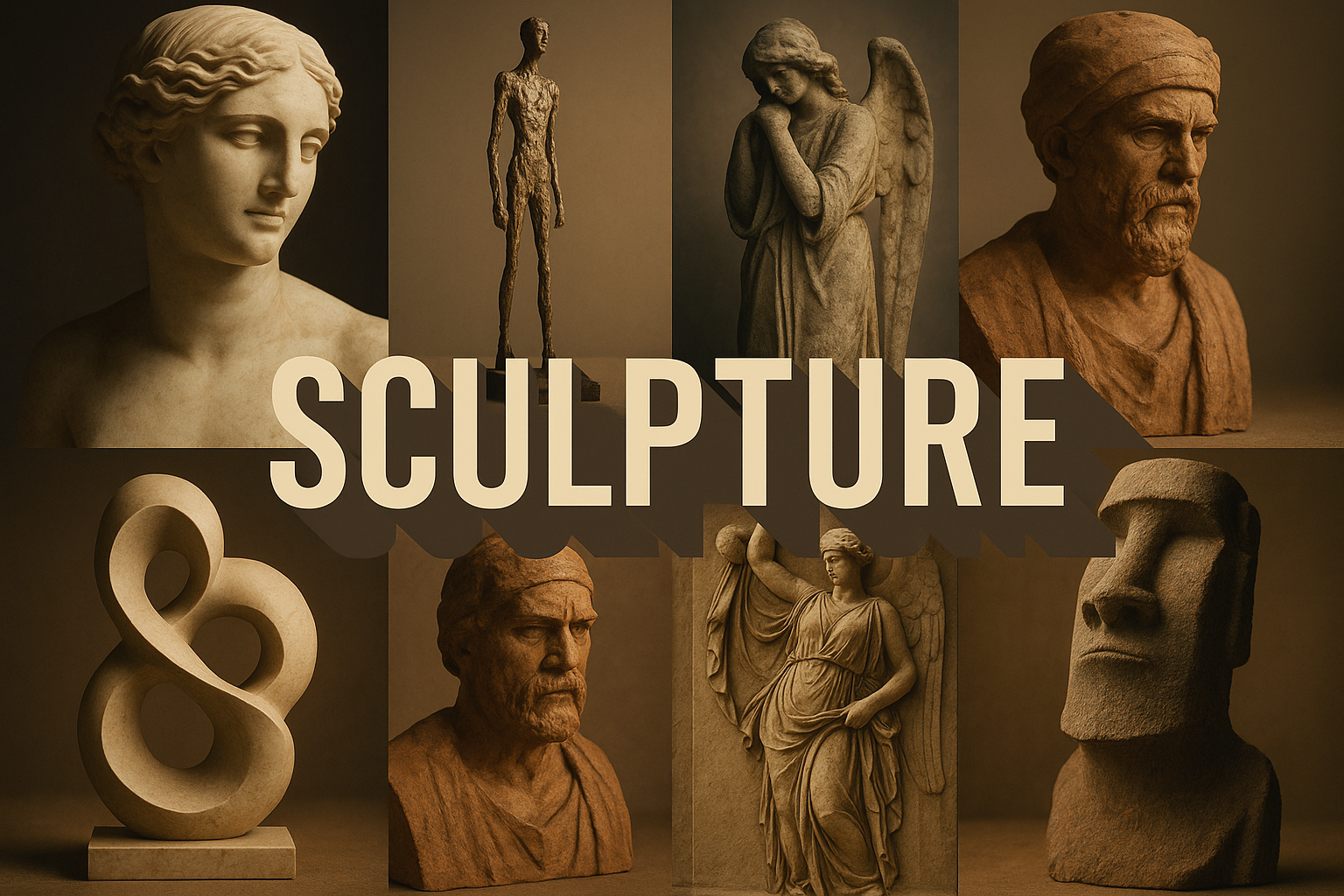
Sculpture
The art style of sculpture is three-dimensional and can be seen from all sides. It is often realistic, but can also be abstract.
AOI thinking about Sculpture [+_~]-/
Overview and Quickfacts
Sculpture is the branch of the visual arts that operates in three dimensions. It is one of the plastic arts. Durable sculptural processes originally used carving (the removal of material) and modelling (the addition of material, as clay), in stone, metal, ceramics, wood and other materials but, since Modernism, there has been an almost complete freedom of materials and process. A wide variety of materials may be worked by removal such as carving, assembled by welding or modelling, or molded or cast.
Can understand it also, as:
Carving, statue, bust, relief
Categorize it as:
Impressionism, Modernism
.: Dreaming :.
holds a HAIKU for the art style
:. Thought is power .:
Detailed Description
Sculpture is the art of creating three-dimensional forms from materials such as stone, metal, wood, or clay. It is one of the oldest art forms in the world, dating back to the days of ancient civilizations such as the Sumerians, Egyptians, and Greeks. Sculpture is a versatile art form that can be used to create everything from small trinkets to massive public monuments. Some of the most famous sculptures in the world include MichelangeloÃÂÃÂs ÃÂÃÂDavidÃÂÃÂ, Auguste RodinÃÂÃÂs ÃÂÃÂThe ThinkerÃÂÃÂ, and the ÃÂÃÂStatue of LibertyÃÂÃÂ. Sculpture can be a very rewarding art form to pursue, both creatively and financially. Many famous sculptures have sold for millions of dollars at auction. If youÃÂÃÂre interested in learning more about sculpture, there are plenty of resources available online and in libraries.
.. beep, beep, beep ..
<START OF TRANSMISSION>
1. Sculpture is the branch of the visual arts that operates in three dimensions. 2. It is one of the plastic arts. 3. Durable sculptural processes originally used carving (the removal of material) and modelling (the addition of material, as clay), in stone, metal, ceramics, wood and other materials but, since Modernism, there has been an almost complete freedom of materials and process. 4. A wide variety of materials may be worked by removal such as carving, assembled by welding or modelling, or molded or cast. 5. Sculpture in the round is the typical form of fine art sculpture, representing figures or scenes in the round. 6. Relief is a type of sculpture that is attached to a background surface. 7. A sculpture may be created by anyone who can shape or model material. 8. The term "sculpture" is often used mainly to describe large works, which are sometimes called monumental sculpture, meaning either or both of sculpture that is large, or that is attached to a building. 9. Smaller works are often called statuary. 10. Sculpture is an important form of public art. 11. A single sculpture is often not considered a work of art, but part of a larger work, such as a building. 12. Many sculptures together in a garden setting may be referred to as a sculpture garden. 13. Sculptures are often placed in public places, such as parks, squares and museums. 14. A person who creates sculptures is called a sculptor. 15. A person who carve in stone is called a stonemason. 16. A person who models in clay is called a clay artist or clay sculptor. 17. A person who models in wax is called a wax modeler. 18. A person who casts sculptures in metal is called a foundryman. 19. A person who carve in wood is called a woodcarver. 20. A person who makes sculptures in ice is called an ice sculptor.
<EOF>
.. robbel bob
Visual Examples from our image gallery
Coming soon, we are so slow .. might never come
Artists, Paintings, and more
(be aware, can be highly speculative)
Artists (be aware, speculation possible):
X
Artworks (be aware, speculation possible)
1. The Thinker – Auguste Rodin, 1880 2. The Kiss – Auguste Rodin, 1886 3. The Burghers of Calais – Auguste Rodin, 1884 4. The Gates of Hell – Auguste Rodin, 1880 5. The Three Graces – Antonio Canova, 1817-1819 6. The Venus de Milo – Alexandros of Antioch, 130-100 BC 7. The Discobolus – Myron, 450-440 BC 8. The Laocoon Group – Hagesandros, Polydorus, and Athanadoros of Rhodes, 1st century AD 9. The Apollo Belvedere – Leochares, 4th century BC 10. The Nike of Samothrace – sculptor unknown, 190 BC 11. The bust of Nefertiti – Thutmose, 1345 BC 12. The Sphinx of Giza – unknown, 2558-2532 BC 13. The Great Pyramid of Giza – unknown, 2560-2540 BC 14. The Temple of Artemis at Ephesus – unknown, 550 BC 15. The Colossus of Rhodes – Chares of Lindos, 280-282 BC 16. The Lighthouse of Alexandria – Sostratus of Cnidus, 280 BC 17. The Mausoleum at Halicarnassus – unknown, 350 BC 18. The Statue of Zeus at Olympia – Phidias, 435 BC 19. The Athena Parthenos – Phidias, 438 BC 20. The Pergamon Altar – unknown, 180-160 BC 21. The Ara Pacis – unknown, 13 BC 22. The Colosseum – unknown, 70-80 AD 23. The Pantheon – unknown, 118-128 AD 24. Trajan’s Column – unknown, 113 AD 25. The Arch of Titus – unknown, 81 AD 26. The Arch of Constantine – unknown, 315 AD 27. The Bamiyan Buddhas – unknown, 6th century AD 28. The Shwedagon Pagoda – unknown, 6th century AD 29. The Statue of Liberty – FrÃÂédÃÂéric Auguste Bartholdi, 1886 30. The Christ the Redeemer – Paul Landowski, 1931
Epoch
X
AI ART RESSOURCES (AKA, well Tools)
Helping tools -> predefined search links on other pages:











